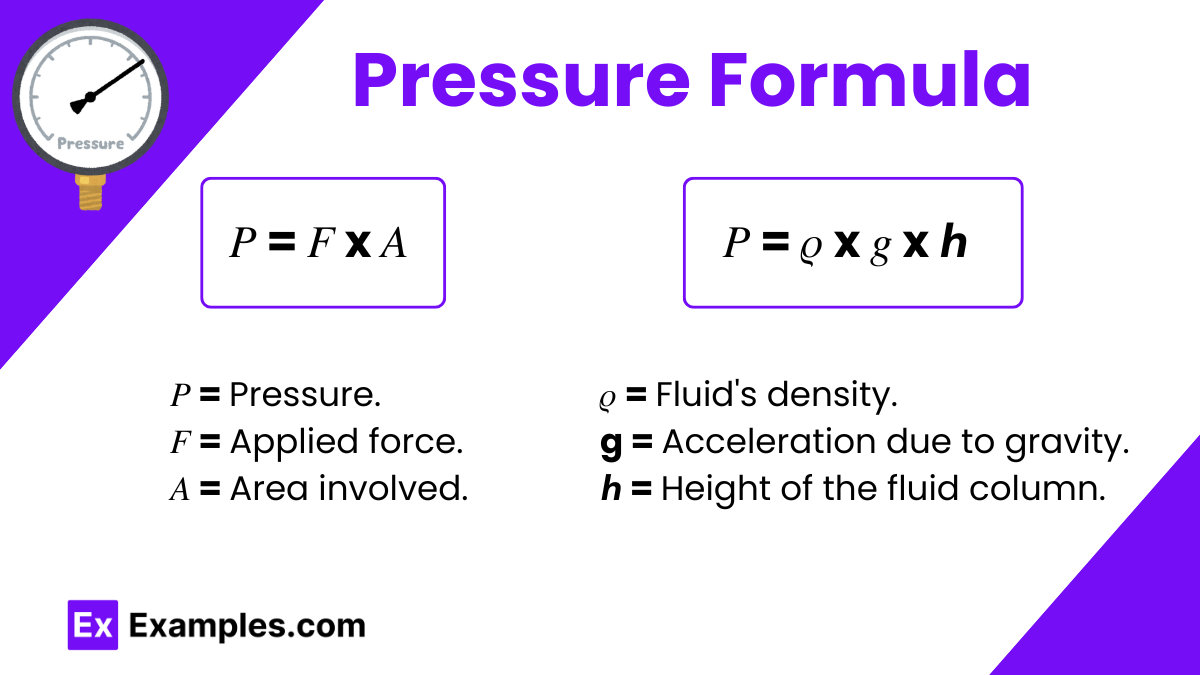Pressure Formula
What is Pressure Formula?
The pressure formula, crucial in physics, quantifies the force per unit area applied to a surface and is expressed as
- 𝑃 represents pressure.
- 𝐹 the applied force.
- 𝐴 the area involved.
Developed by figures like Blaise Pascal, this formula is vital for studying phenomena in physics, engineering, and meteorology. Additionally, the hydrostatic pressure formula calculates the pressure exerted by a fluid at equilibrium due to gravity.
- 𝜌 is the fluid’s density
- 𝑔 the acceleration due to gravity
- ℎ the height of the fluid column.
Both formulas are foundational for predicting and understanding the behavior of gases and liquids under various conditions, enhancing our grasp of natural and engineered systems.
Applications of Pressure Formula
- Weather Forecasting: Meteorologists use the pressure formula to predict weather changes by analyzing atmospheric pressure variations.
- Designing Hydraulic Systems: Engineers apply the formula to design systems like brakes and hydraulic lifts, ensuring they operate safely under the right pressure.
- Calculating Force in Pistons: The formula helps in calculating the force exerted by pistons in engines and pumps, critical for their efficiency and functionality.
- Understanding Deep-Sea Conditions: Scientists calculate the pressure exerted on submarines and underwater equipment to ensure structural integrity at great depths.
- Medical Applications: The formula is used to monitor blood pressure and design medical devices that rely on precise pressure measurements, such as ventilators and IV drips.
Example Problems on Pressure Formula
Example 1: Calculating Pressure Inside a Tire
Problem: A force of 1500 Newtons is exerted over an area of 0.035 square meters in a car tire. What is the pressure inside the tire?
Solution: Use the pressure formula 𝑃=𝐹 / 𝐴.
- 𝐹= 1500 Newtons
- 𝐴=0.035 square meters
𝑃=1500 / 0.035=42857.14 Pascals
Example 2: Force Exerted by a Hydraulic Press
Problem: A hydraulic press exerts a pressure of 200,000 Pascals. If the contact area between the press and the block is 0.1 square meters, calculate the force exerted by the press.
Solution: Rearrange the formula to solve for F : 𝐹 = 𝑃 × 𝐴.
- 𝑃=200,000 Pascals
- 𝐴=0.1 square meters
𝐹=200,000 × 0.1=20,000 Newtons
Example 3: Height of Water in a Tank
Problem: The hydrostatic pressure at the bottom of a tank filled with water is 500 Pascals. Given the density of water is 1000 kg/m³, calculate the height of the water column.
Solution: Use the hydrostatic pressure formula 𝑃 = 𝜌 x 𝑔 x ℎ and rearrange to solve for ℎ:
- 𝑃=500 Pascals
- 𝜌=1000 kg/m³
- 𝑔=9.81 m/s² (acceleration due to gravity)
ℎ = 𝑃 x 𝜌 x 𝑔 = 500 x 1000×9.81 = 0.051 meters
FAQs
What is Pressure Formula and Its Unit?
The pressure formula is 𝑃=𝐹𝐴, where P represents pressure, measured in Pascals (Pa).
What Are the 3 Units of Pressure?
Pressure is commonly measured in Pascals (Pa), atmospheres (atm), and pounds per square inch (psi).
What is the g in Pressure Formula?
In the pressure formula, g represents the acceleration due to gravity, typically 9.81 m/s² on Earth.



